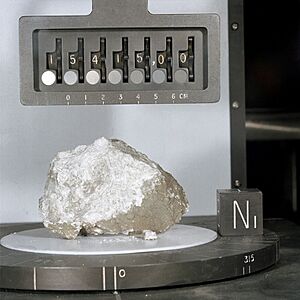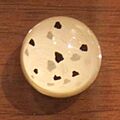Moon rock facts for kids
Moon rocks are special pieces of rock that come from our Moon. They are also called lunar rocks. Scientists have collected these rocks in two main ways. Some were brought back by astronauts and robotic spacecraft. Others fell to Earth naturally as lunar meteorites after being blasted off the Moon's surface.

Contents
Where Do Moon Rocks Come From?
Scientists have found Moon rocks on Earth from four main places. Most were collected by astronauts during the Apollo program. Some were gathered by robotic probes from the Soviet Union and China. The rest are lunar meteorites that landed on Earth naturally.
Apollo Missions: Astronauts' Discoveries
The United States sent six Apollo missions to the Moon. These missions had astronauts on board. From 1969 to 1972, they collected a lot of Moon rocks. They brought back about 381 kilograms (840 pounds) of samples. This was divided into over 110,000 smaller pieces for study.
| Mission | Landing Site | Amount of Rock Returned | Year |
|---|---|---|---|
| Apollo 11 | Mare Tranquillitatis | 47.51 kg (104.74 lb) | 1969 |
| Apollo 12 | Ocean of Storms | 75.62 kg (166.71 lb) | 1969 |
| Apollo 14 | Fra Mauro formation | 94.35 kg (207.99 lb) | 1971 |
| Apollo 15 | Hadley–Apennine | 169.10 kg (372.80 lb) | 1971 |
| Apollo 16 | Descartes Highlands | 209.89 kg (462.73 lb) | 1972 |
| Apollo 17 | Taurus–Littrow | 243.40 kg (536.61 lb) | 1972 |
Luna Missions: Robotic Explorers
The Soviet Union also sent missions to the Moon. Their Luna program used robotic spacecraft. These robots could collect small samples and bring them back to Earth. Three Luna missions successfully returned Moon rocks. They brought back a total of about 301 grams (10.6 ounces). This is less than half a kilogram.
| Mission | Landing Site | Amount of Rock Returned | Year |
|---|---|---|---|
| Luna 16 | Mare Fecunditatis | 101 g (3.6 oz) | 1970 |
| Luna 20 | Mare Fecunditatis | 30 g (1.1 oz) | 1972 |
| Luna 24 | Mare Crisium | 170 g (6.0 oz) | 1976 |
These Moon rocks are very valuable. For example, some small pieces from Luna 16 were sold for a lot of money.
Chang'e Missions: China's Lunar Samples
China has also sent robotic missions to the Moon. These are part of the Chinese Lunar Exploration Program. The Chang'e 5 mission in 2020 brought back about 1.7 kilograms (3.8 pounds) of rocks and dust. These samples came from a large dark area called Oceanus Procellarum. Scientists found a new mineral in these samples. They named it Changesite-(Y).
| Mission | Landing Site | Amount of Rock Returned | Year |
|---|---|---|---|
| Chang'e 5 | Mons Rümker | 1731 g (3.82 lb) | 2020 |
| Chang'e 6 | Southern Apollo crater | 1935.3 g (4.27 lb) | 2024 |
The Chang'e 6 mission was even more special. In June 2024, it landed on the far side of the Moon. This was the first time anyone collected samples from that hidden side. The probe used a mechanical arm to scoop up soil and rocks. It also drilled into the Moon's surface.
Scientists are thinking about using Moon rocks for future lunar bases. For example, they might turn basalt rock into strong fibers. These fibers could be used as building materials. The Chang'e 6 samples were brought back to Earth in June 2024. They landed safely in Inner Mongolia, China.
Moon Rocks That Fell to Earth
Sometimes, pieces of the Moon naturally break off. This can happen when a large asteroid hits the Moon. These pieces then travel through space. If they land on Earth, they are called lunar meteorites. Over 370 lunar meteorites have been found. Their total weight is more than 1,090 kilograms (2,400 pounds).
Many of these meteorites were found in Antarctica by science teams. Others were discovered by people searching in the deserts of northern Africa and Oman. These natural Moon rocks are also very valuable.
How Old Are Moon Rocks?
Scientists can figure out how old Moon rocks are. They use a method called radiometric dating. This method looks at tiny changes in the elements inside the rocks. The youngest Moon rocks are about 3.16 billion years old. These are often basalt rocks from the Moon's dark plains, called maria.
The oldest Moon rocks are about 4.44 billion years old. These come from the Moon's brighter, higher areas, called highlands. For comparison, the oldest rocks found on Earth are between 3.8 and 4.28 billion years old. This shows that some parts of the Moon are even older than Earth's oldest rocks.
What Are Moon Rocks Made Of?
Moon rocks are different from rocks on Earth. They usually don't have much water or other easily evaporated substances. However, they are similar to Earth rocks in how their oxygen atoms are made up. Scientists use special tools to collect Moon rocks. These include hammers, rakes, scoops, and tongs. The rocks are carefully placed in special containers to keep them safe and clean.
Moon rocks generally fit into two main groups. These depend on where they were found on the Moon.
- Highlands rocks: These come from the Moon's brighter, higher areas. They are often made of a mineral called anorthite.
- Mare basalts: These come from the Moon's darker, flatter plains. They often have a lot of iron and sometimes high levels of titanium.
Here are some common minerals found in Moon rocks:
| Mineral | What It's Made Of | How It Looks |
|---|---|---|
| Plagioclase feldspar | Calcium, Aluminium, Silicon, Oxygen | White to clear gray; often long grains. |
| Pyroxene | Iron, Magnesium, Calcium, Silicon, Oxygen | Maroon to black; long grains in dark plains, square in highlands. |
| Olivine | Iron, Magnesium, Silicon, Oxygen | Greenish color; usually rounded shape. |
| Ilmenite | Iron, Titanium, Oxygen | Black, long square crystals. |
Exploring Highlands Rocks
The Moon's highlands are the older, brighter parts of its surface. Rocks from these areas are mostly made of a mineral called plagioclase feldspar. This mineral is very common in the highlands.
Scientists group these rocks into different types:
- Ferroan Anorthosite: This is the most common type. It's almost entirely made of anorthosite. This rock likely formed when the Moon was very young and covered in a deep ocean of molten rock.
- Magnesian Suite: These rocks, like dunites and troctolites, formed later. They pushed their way into the Moon's crust. They have a lot of magnesium.
- Alkali Suite: These rocks, like some anorthosites and norites, have more alkali elements. They also formed later than the ferroan anorthosites.
- Lunar Granites: These are rare Moon rocks. They are similar to granites found on Earth. They likely formed from melted rock deep inside the Moon.
- Lunar Breccias: These rocks are made of many different rock fragments stuck together. They form when asteroids hit the Moon very hard. The impacts break up rocks and sometimes melt them. This creates new rocks with pieces of older ones inside.
| Plagioclase | Pyroxene | Olivine | Ilmenite | |
|---|---|---|---|---|
| Anorthosite | 90% | 5% | 5% | 0% |
| Norite | 60% | 35% | 5% | 0% |
| Troctolite | 60% | 5% | 35% | 0% |
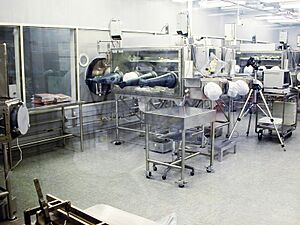
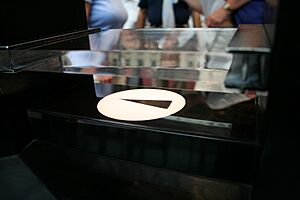
Understanding Mare Basalts
Mare basalts are volcanic rocks. They make up the large, dark plains on the Moon called lunar maria. These rocks are similar to volcanic rocks on Earth. However, they have some important differences. For example, they often have a lot of iron and titanium.
| Plagioclase | Pyroxene | Olivine | Ilmenite | |
|---|---|---|---|---|
| High titanium content | 30% | 54% | 3% | 18% |
| Low titanium content | 30% | 60% | 5% | 5% |
| Very low titanium content | 35% | 55% | 8% | 2% |
One special type is called KREEP Basalts. These rocks have a lot of potassium. They also contain other rare elements. KREEP basalts are often found around the Oceanus Procellarum area.
Where Are Moon Rocks Kept?
Most of the Moon rocks brought back by the Apollo missions are stored at the Lunar Sample Laboratory Facility. This special lab is located at the Lyndon B. Johnson Space Center in Houston, Texas. A smaller collection is kept safe at the White Sands Test Facility in Las Cruces, New Mexico.
Scientists store these rocks in a special gas called nitrogen. This keeps them safe from moisture and other things that could damage them. They use special tools to handle the rocks. This prevents any contamination.
Some Moon rocks are put on display in museums. A few museums even let visitors gently touch a real Moon rock. These rocks are considered extremely valuable.
Goodwill Moon Rocks: Gifts to the World
After the Apollo 17 mission, astronauts Eugene Cernan and Harrison Schmitt collected a special rock. This rock was made of many different pieces from all over the Moon. It was named sample 70017.
In 1973, President Nixon decided to share pieces of this rock. Small fragments were given to all 50 U.S. states. They were also given to leaders of 135 other countries. Each piece was placed inside a clear sphere. It was mounted on a wooden plaque. The plaque also had a flag that had flown to the Moon on Apollo 17. These gifts were meant to show goodwill and friendship.
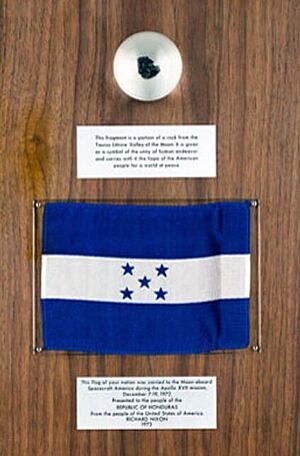
New Minerals Found on the Moon
Scientists have discovered three new minerals on the Moon. These minerals were not known to exist on Earth before. They are called armalcolite, tranquillityite, and pyroxferroite.
The mineral armalcolite was named after the three astronauts from the Apollo 11 mission. Their names were Neil Armstrong, Buzz Aldrin, and Michael Collins. The name "Armalcolite" comes from parts of their last names: Armstrong, Aldrin, and Collins.
Protecting Our Moon Rocks
Moon rocks are incredibly rare and valuable. It is very hard to get more of them. Because of this, some Moon rocks have unfortunately gone missing or been stolen. Scientists and museums work hard to keep these precious samples safe.
Images for kids
-
A visitor touching a lunar sample at the Kennedy Space Center Visitor Complex
-
NASA Lunar sample 15555 on display at Space Center Houston Lunar Samples Vault, at NASA's Johnson Space Center
-
NASA Lunar sample 15498 on display at Space Center Houston Lunar Samples Vault, at NASA's Johnson Space Center
-
NASA Lunar sample 60015 on display at Space Center Houston Lunar Samples Vault, at NASA's Johnson Space Center
-
NASA Lunar sample 60016 on display at Space Center Houston Lunar Samples Vault, at NASA's Johnson Space Center
-
NASA Lunar Sample Return Container with Lunar soil on display at Space Center Houston Lunar Samples Vault, at NASA's Johnson Space Center
-
Lunar Ferroan Anorthosite #60025 (Plagioclase Feldspar). Collected by Apollo 16 from the Lunar Highlands near Descartes Crater. This sample is currently on display at the National Museum of Natural History in Washington, DC
-
Samples in Lunar Sample Building at JSC
-
A piece of regolith from Apollo 11 presented to the Soviet Union and exhibited in the Memorial Museum of Cosmonautics in Moscow.
-
Cut fragment of Apollo 17 sample 76015, an impact melt breccia
-
Big Bertha, collected on Apollo 14, is among the largest rock samples returned from the Moon (nearly 9 kilograms)
-
Moon rocks on display at the National Museum of China
See Also
- Geology of the Moon
- Lunar meteorite
- Lunar regolith
- Sample-return mission
- List of Apollo lunar sample displays
- Lunar water


